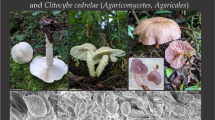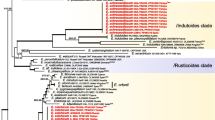Abstract
Amyloporia pinea sp. nov. is described and illustrated on the basis of collections from southern China. Morphology and phylogenetic analysis of rDNA ITS sequences support this new species. Morphologically, it is characterized by resupinate, annual basidiocarps, cream to yellowish buff pore surface when fresh, which becomes yellowish brown to clay-buff upon drying, a dimitic hyphal system with clamped generative hyphae and inamyloid skeletal hyphae, fusoid cystidioles, and cylindrical basidiospores; moreover, it causes a brown rot. Molecular phylogeny inferred from ITS sequence data suggested a close relationship between A. pinea and Amyloporia crassa sensu lato. Antrodia subxantha has amyloid skeletal hyphae, and grouped within the Amyloporia clade, hence, it is transferred to Amyloporia, and a new combination Amyloporia subxantha is proposed.



Similar content being viewed by others
References
Bernicchia A, Ryvarden L (2001) A new Antrodia species (Coriolaceae, Basidiomycetes). Mycotaxon 79:57–66
Bernicchia A, Gorjón SP, Vampola P, Ryvarden L, Prodi A (2012) A phylogenetic analysis of Antrodia s.l. based on nrDNA ITS sequences, with emphasis on rhizomorphic European species. Mycol Prog 11:93–100
Chiu HH (2007) Phylogenetic analysis of Antrodia species and Antrodia camphorata inferred from internal transcribed spacer region. Antonie Leeuwenhoek 91:267–276
Cui BK (2013) Antrodia tropica sp. nov. from southern China inferred from morphological characters and molecular data. Mycol Prog 12:223–230
Cui BK, Li HJ (2012) A new species of Postia (Basidiomycota) from Northeast China. Mycotaxon 120:231–237
Cui BK, Li HJ, Dai YC (2011) Wood-rotting fungi in eastern China 6. Two new species of Antrodia (Basidiomycota) from Mt. Huangshan Anhui Province. Mycotaxon 116:13–20
Dai YC (2012) Polypore diversity in China with an annotated checklist of Chinese polypores. Mycoscience 53:49–80
Dai YC, Niemelä T (2002) Changbai wood-rotting fungi 13 Antrodia sensu lato. Ann Bot Fenn 39:257–265
Dai YC, Penttilä R (2006) Polypore diversity of Fenglin Nature Reserve, northeastern China. Ann Bot Fenn 43:81–96
Dai YC, He XS, WangHe KY, Steffen K (2012) Wood-decaying fungi in eastern Himalayas 2: species from Qingcheng Mts Sichuan Province. Mycosystema 31:168–173
Felsenstein J (1985) Confidence intervals on phylogenetics: an approach using bootstrap. Evolution 39:783–791
Gilbertson RL, Ryvarden L (1986) North American polypores 1. Fungiflora, Oslo
Hall TA (1999) Bioedit: a user-friendly biological sequence alignment editor and analysis program for Windows 95/98/NT. Nucleic Acids Symp Ser 41:95–98
Karsten P (1879) Symbolae ad mycologiam Fennicam 6. Meddel. Soc. Fauna Flora Fennica 5:15–46
Kim SY, Park SY, Jung HS (2001) Phylogenetic classification of Antrodia and related genera based on ribosomal RNA internal transcribed spaces sequences. J Microbiol Biotechnol 11:475–481
Kim SY, Park SY, Ko KS, Jung HS (2003) Phylogenetic analysis of Antrodia and related taxa based on partial mitochondrial SSU rDNA sequences. Antonie Leeuwenhoek 83:81–88
Kirk PM, Cannon PF, Minter DW, Stalpers JA (2008) Dictionary of the Fungi, 10th edn. CAB International, Wallingford
Li HJ, Cui BK (2013a) Two new Daedalea species (Polyporales, Basidiomycota) from South China. Mycoscience 54:62–68
Li HJ, Cui BK (2013b) Taxonomy and phylogeny of the genus Megasporoporia and its related genera. Mycologia 105:368–383
Li HJ, Han ML, Cui BK (2013) Two new Fomitopsis species from southern China based on morphological and molecular evidences. Mycol Prog. doi:10.1007/s11557-012-0882-2
Núñez M, Ryvarden L (2001) East Asian polypores 2. Syn Fungorum 14:165–522
Nylander JAA (2004) MrModeltest v2 program distributed by the author. Evolutionary Biology Centre, Uppsala University
Petersen JH (1996) Farvekort. The Danish Mycological Society′s colour-chart. Foreningen til Svampekundskabens Fremme, Greve
Posada D, Crandall KA (1998) Modeltest: testing the model of DNA substitution. Bioinformatics 14:817–818
Rajchenberg M, Gorjón SP, Pildain MB (2011) The phylogenetic disposition of Antrodia s.l. (Polyporales, Basidiomycota) from Patagonia Argentina. Aust Syst Bot 24:111–120
Ronquist F, Huelsenbeck JP (2003) MRBAYES 3: bayesian phylogenetic inference under mixed models. Bioinformatics 19:1572–1574
Ryvarden L (1991) Genera of polypores nomenclature and taxonomy. Syn Fungorum 5:1–363
Ryvarden L, Gilbertson RL (1993) European polypores 1. Syn Fungorum 6:1–387
Spirin V, Miettinen O, Pennanen J, Kotiranta H, Niemelä T (2013) Antrodia hyalina, a new polypore from Russia, and A. leucaena, new to Europe. Mycol Prog 12:53–61
Stöger A, Schaffer J, Ruppitsch W (2006) A rapid and sensitive method for direct detection of Erwinia amylovora in symptomatic and asymptomatic plant tissues by polymerase chain reaction. J Phytopathol 154:469–473
Swofford DL (2002) PAUP*: phylogenetic analysis using parsimony (*and other methods). Version 4.0b10. Sinauer Associates, Sunderland
Thomson JD, Gibson TJ, Plewniak F, Jeanmougin F, Higgins DG (1997) The clustal_X windows interface: flexible strategies for multiple sequence alignment aided by quality analysis tools. Nucleic Acids Res 25:4876–4882
Wei YL, Dai YC (2006) Three new species of Postia (Aphyllophorales, Basidiomycota) from China. Fungal Divers 23:391–402
White TJ, Bruns TD, Lee S, Taylor J (1990) Amplification and direct sequencing of fungal ribosomal RNA genes for phylogenetics. In: Innis MA, Gelfand DH, Sninsky JJ, White TJ (eds) PCR protocols, a guide to methods and applications. Academic, San Diego, pp 315–322
Wu SH, Yu ZH, Dai YC, Chen CT, Su CH, Chen LC, Hsu WC, Hwang GY (2004) Taiwanofungus, a polypore new genus. Fungal Sci 19:109–116
Yu ZH, Wu SH, Wang DM, Chen CT (2010) Phylogenetic relationships of Antrodia species and related taxa based on analyses of nuclear large subunit ribosomal DNA sequences. Bot Stud 51:53–60
Zhao CL, Cui BK, Dai YC (2013) New species and phylogeny of Perenniporia based on morphological and molecular characters. Fungal Divers 58:47–60
Acknowledgments
The authors are grateful to Drs Wei Li and Xiao-Yong Liu (HMAS, China) for companionship during field collections, to Dr. Jia–Jia Chen (BJFC, China) for preparing the line drawings, and to Drs. Chang-Lin Zhao (BJFC, China) and Josef Vlasák (České Budějovice, Czech Republic) for help in the DNA extraction. Dr. Karl-Henrik Larsson (O, Norway) was deeply thanked for loan of specimens. The research was financed by the Fundamental Research Funds for the Central Universities (Project no. JC2013-1), the National Natural Science Foundation of China (Project no. 31170018) and the Program for New Century Excellent Talents in University (NCET-11-0585).
Author information
Authors and Affiliations
Corresponding author
Rights and permissions
About this article
Cite this article
Cui, BK., Dai, YC. Molecular phylogeny and morphology reveal a new species of Amyloporia (Basidiomycota) from China. Antonie van Leeuwenhoek 104, 817–827 (2013). https://doi.org/10.1007/s10482-013-9994-1
Received:
Accepted:
Published:
Issue Date:
DOI: https://doi.org/10.1007/s10482-013-9994-1




